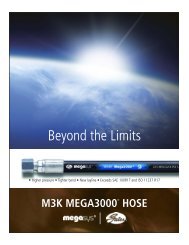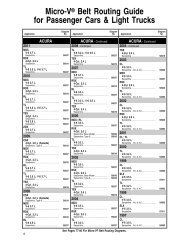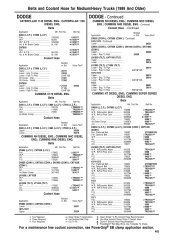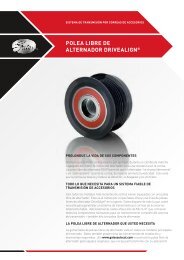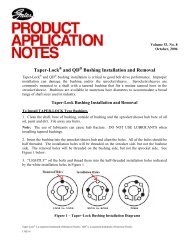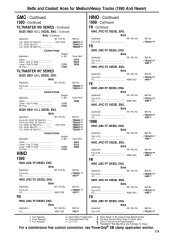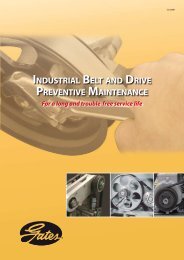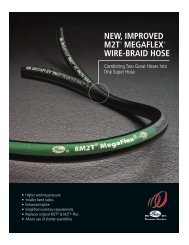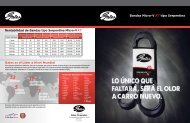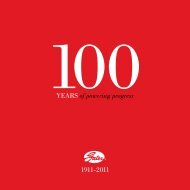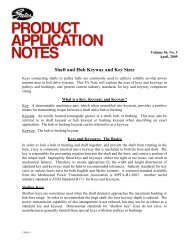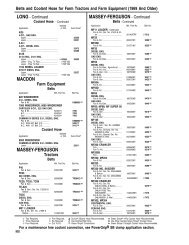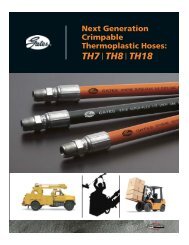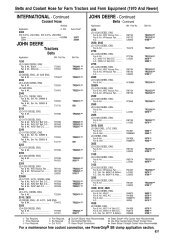PowerGrip® GT® Belt Drives
PowerGrip® GT® Belt Drives
PowerGrip® GT® Belt Drives
You also want an ePaper? Increase the reach of your titles
YUMPU automatically turns print PDFs into web optimized ePapers that Google loves.
Synchronous <strong>Belt</strong> <strong>Drives</strong> – Engineering<br />
I. Operating Characteristics<br />
NOTE: This engineering section provides general<br />
engineering information for synchronous belts and<br />
sprockets (or pulleys) which are useful in general<br />
drive design work. Where we refer to sprockets (for<br />
PowerGrip GT and HTD belts), you can substitute<br />
pulleys for PowerGrip Timing <strong>Belt</strong>s. If you need<br />
additional information, contact Gates Application<br />
Engineering, Denver.<br />
A. Low Speed Operation<br />
Synchronous drives are especially well suited for<br />
low speed-high torque applications. Their positive<br />
driving nature prevents potential slippage<br />
associated with V-belt drives, and even allows<br />
significantly greater torque carrying capability.<br />
Small pitch synchronous drives operating at speeds<br />
of 50 ft./min. (.25 m/s) or less are considered to be<br />
low speed. Care should be taken in the drive<br />
selection process as stall and peak torques can<br />
sometimes be very high. While intermittent peak<br />
torques can often be carried by synchronous drives<br />
without special considerations, high cyclic peak<br />
torque loading should be carefully reviewed.<br />
Proper belt installation tension and rigid drive<br />
bracketry and framework is essential in preventing<br />
belt tooth jumping under peak torque loads. It is<br />
also helpful to design with more than the normal<br />
minimum of 6 belt teeth in mesh to ensure adequate<br />
belt tooth shear strength.<br />
Newer generation curvilinear systems like<br />
PowerGrip GT and PowerGrip HTD should be used<br />
in low speed-high torque applications, as<br />
PowerGrip Timing <strong>Belt</strong>s are more prone to tooth<br />
jumping, and have significantly less load carrying<br />
capacity.<br />
B. High Speed Operation<br />
Synchronous belt drives are often used in high<br />
speed applications even though V-belt drives are<br />
typically better suited. They are often used because<br />
of their positive driving characteristic (no creep or<br />
slip), and because they require minimal<br />
maintenance (don’t stretch significantly). A<br />
significant drawback of high speed synchronous<br />
drives is drive noise. High speed synchronous<br />
drives will nearly always produce more noise than<br />
V-belt drives. Small pitch synchronous drives<br />
operating at speeds in excess of 1300 ft/min (6.6<br />
m/s) are considered to be high speed.<br />
Special considerations should be given to high<br />
speed drive designs, as a number of factors can<br />
significantly influence belt performance. Cord<br />
fatigue and belt tooth wear are the two most<br />
significant factors that must be controlled to ensure<br />
success. Moderate sprocket diameters should be<br />
used to reduce the rate of cord flex fatigue.<br />
Designing with a smaller pitch belt will often<br />
provide better cord flex fatigue characteristics than a<br />
larger pitch belt. PowerGrip GT is especially well<br />
suited for high speed drives because of its excellent<br />
belt tooth entry/exit characteristics. Smooth<br />
interaction between the belt tooth and sprocket<br />
groove minimizes wear and noise. <strong>Belt</strong> installation<br />
tension is especially critical with high speed drives.<br />
Low belt tension allows the belt to ride out of the<br />
driveN sprocket resulting in rapid belt tooth and<br />
sprocket groove wear.<br />
C. Smooth Running<br />
Some ultra-sensitive applications require the belt<br />
drive to operate with as little vibration as possible,<br />
as vibration sometimes has an effect on the system<br />
operation or finished manufactured product. In these<br />
cases, the characteristics and properties of all<br />
appropriate belt drive products should be reviewed.<br />
The final drive system selection should be based<br />
upon the most critical design requirements, and<br />
may require some compromise.<br />
Vibration is not generally considered to be a<br />
problem with synchronous belt drives. Low levels of<br />
vibration typically result from the process of tooth<br />
meshing and/or as a result of their high tensile<br />
modulus properties. Vibration resulting from tooth<br />
meshing is a normal characteristic of synchronous<br />
belt drives, and cannot be completely eliminated. It<br />
can be minimized by avoiding small sprocket<br />
diameters, and instead choosing moderate sizes.<br />
The dimensional accuracy of the sprockets also<br />
influences tooth meshing quality. Additionally, the<br />
installation tension has an impact on meshing<br />
quality. PowerGrip GT drives mesh very cleanly,<br />
resulting in the smoothest possible operation.<br />
Vibration resulting from high tensile modulus can<br />
be a function of sprocket quality. Radial run out<br />
causes belt tension variation with each sprocket<br />
revolution. V-belt sheaves are also manufactured<br />
with some radial run out, but V-belts have a lower<br />
tensile modulus resulting in less belt tension<br />
variation. The high tensile modulus found in<br />
synchronous belts is necessary to maintain proper<br />
pitch under load.<br />
D. Drive Noise<br />
Drive noise evaluation in any belt drive system<br />
should be approached with care. There are many<br />
potential sources of noise in a system including<br />
vibration from related components, bearings, and<br />
resonance and amplification through framework and<br />
panels.<br />
Synchronous belt drives typically produce more<br />
noise than V-belt drives. Noise results from the<br />
process of belt tooth meshing and physical contact<br />
with the sprockets. The sound pressure level<br />
generally increases as operating speed and belt<br />
width increase, and as sprocket diameter decreases.<br />
<strong>Drives</strong> designed on moderate sprocket sizes without<br />
excessive capacity (over designed) are generally the<br />
quietest. PowerGrip GT drives have been found to<br />
be significantly quieter than other systems due to<br />
their improved meshing characteristics.<br />
Polyurethane belts generally produce more noise<br />
than neoprene belts. Proper belt installation tension<br />
is also very important in minimizing drive noise.<br />
The belt should be tensioned at a level that allows it<br />
to run with as little meshing interference as<br />
possible. See section III. <strong>Belt</strong> Tensioning on pages<br />
49-51 for additional tensioning guidelines.<br />
Drive alignment also has a significant effect on drive<br />
noise. Special attention should be given to<br />
minimizing angular misalignment (shaft<br />
parallelism). This assures that belt teeth are loaded<br />
uniformly and minimizes side tracking forces<br />
against the flanges. Parallel misalignment (sprocket<br />
offset) is not as critical of a concern so long as the<br />
belt is not trapped or pinched between opposite<br />
flanges. Refer to section II. Drive Alignment on page<br />
49 for more discussion on misalignment. Sprocket<br />
materials and dimensional accuracy also influence<br />
drive noise. Some users have found that steel<br />
sprockets are the quietest followed closely by<br />
aluminum. Polycarbonates have been found to be<br />
noisier than metallic materials. Machined sprockets<br />
are generally quieter than molded sprockets. The<br />
reasons for this revolve around material density and<br />
resonance characteristics as well as dimensional<br />
accuracy.<br />
E. Static Conductivity<br />
Small synchronous rubber or urethane belts can<br />
generate an electrical charge while operating on a<br />
drive. Factors such as humidity and operating speed<br />
influence the potential of the charge. If determined<br />
to be a problem, rubber belts can be produced in a<br />
conductive construction to dissipate the charge into<br />
the sprockets, and to ground. This prevents the<br />
accumulation of electrical charges that might be<br />
detrimental to material handling processes or<br />
sensitive electronics. It also greatly reduces the<br />
potential for arcing or sparking in flammable<br />
environments. Urethane belts cannot be produced in<br />
a conductive construction.<br />
The World’s Most Trusted Name in <strong>Belt</strong>s, Hose & Hydraulics.<br />
45



